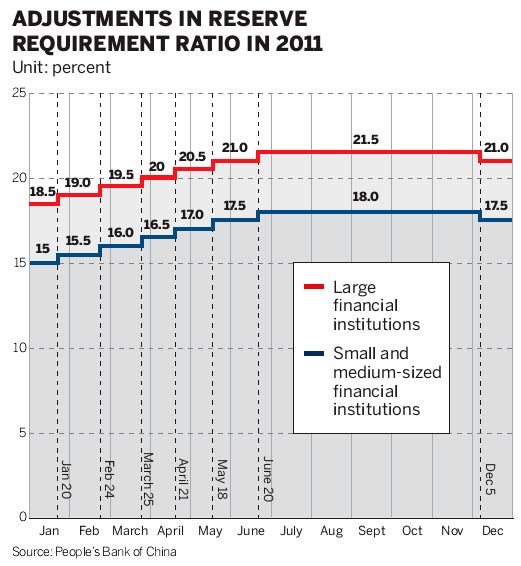Experts call for easing monetary policy
Updated: 2012-06-06 09:10
By Chen Jia (China Daily)
|
||||||||
The depressing picture painted by China's recent economic data has encouraged some economists to call for the use of monetary levers to increase bank credit and stabilize economic growth.
Some policy watchers expect a cut in the commercial banks' reserve requirement ratio by at least 50 basis points, as well as a reduction in benchmark interest rates of 0.25 percentage points by the end of this month.
Other economists close to the government suggested that monetary policy easing could be more selective, by lowering the lending rate, promoting market-based interest rate reform and injecting liquidity into the capital market.
In the second half of this year, China is expected to enter into a period of consecutive RRR cuts, said Ba Shusong, a senior economist with the Development Research Center of the State Council.
"It is likely that in the next one or two years the central bank will need to continually reduce the RRR to boost market liquidity, as yuan holdings for foreign exchange purchases may decrease thanks to gloomy exports amid weakening global economic growth," Ba said.
China started a cycle of RRR cuts last December, which has released about 400 billion yuan ($63 billion) into the capital market, after three years of monetary tightening.
So far this year, the People's Bank of China has cut the RRR twice, in February and May, to help cash-strapped companies, especially smaller firms.
Last year, the central bank raised the RRR six times to 21.5 percent and increased interest rates three times. The current one-year deposit rate is 3.5 percent, while the lending rate is 6.56 percent.
"I don't agree with a general decrease in interest rates as inflationary pressures still exist, and the problem of excess production capacity is very obvious now," said Ba.
He suggested lowering the fluctuation limit of the minimum credit rate to 70 percent of the benchmark rate from the current 90 percent, which would decrease companies' borrowing costs and satisfy their credit demand.
The latest economic indicator - the official purchasing managers' index - pointed to deteriorating conditions in the manufacturing sector.
The figure sharply dropped to 50.4 last month from 53.3 in April, approaching the 50 mark that separates expansion from contraction.
"The manufacturing industry is under pressure from slowing profit growth and a gloomy market outlook, which can influence credit demand in the near term and further reduce output," said Xu Hongcai, a senior economist with the China Center for International Economic Exchanges, a government think tank.
A report issued on Tuesday by Fitch Ratings Inc says broad credit growth in the world's second-largest economy may continue to decelerate, adding to pressures on the economy.
"Broad credit growth began to moderate in the second half of 2011, and this slowdown has accelerated in 2012," said Charlene Chu, head of Chinese banks' ratings at Fitch.
"Weakening demand for credit as well as resource constraints from thinning bank liquidity has been weighing on bank lending."

 Relief reaches isolated village
Relief reaches isolated village
 Rainfall poses new threats to quake-hit region
Rainfall poses new threats to quake-hit region
 Funerals begin for Boston bombing victims
Funerals begin for Boston bombing victims
 Quake takeaway from China's Air Force
Quake takeaway from China's Air Force
 Obama celebrates young inventors at science fair
Obama celebrates young inventors at science fair
 Earth Day marked around the world
Earth Day marked around the world
 Volunteer team helping students find sense of normalcy
Volunteer team helping students find sense of normalcy
 Ethnic groups quick to join rescue efforts
Ethnic groups quick to join rescue efforts
Most Viewed
Editor's Picks

|

|

|

|

|

|
Today's Top News
Health new priority for quake zone
Xi meets US top military officer
Japan's boats driven out of Diaoyu
China mulls online shopping legislation
Bird flu death toll rises to 22
Putin appoints new ambassador to China
Japanese ships blocked from Diaoyu Islands
Inspired by Guan, more Chinese pick up golf
US Weekly

|

|








